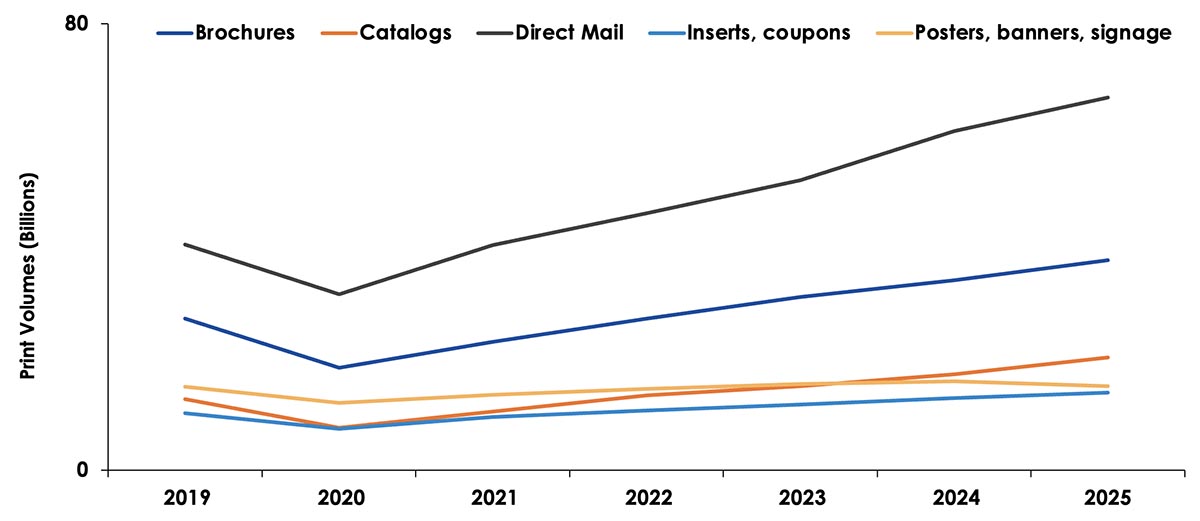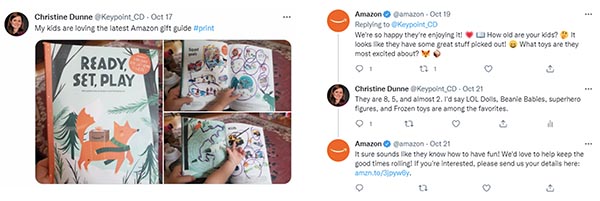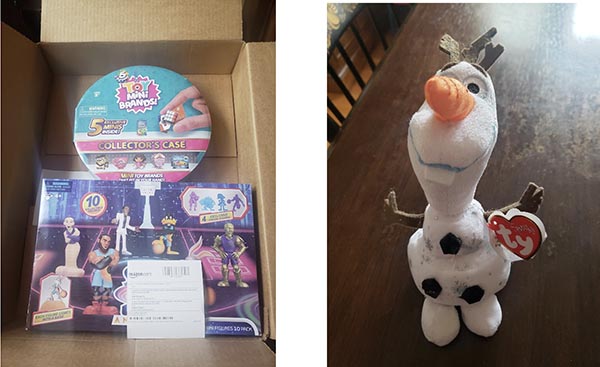- Catalog volumes suffered a decline between 2007 and 2018, but the future is not necessarily bleak.
- Recent forecast data from Keypoint Intelligence suggests that catalog volumes will continue to rebound through 2025.
- Printed catalogs don’t need to be just a tool that convinces consumers to buy right away—they can also be used to deepen a consumer’s connection to a brand.
By Christine Dunne
Introduction
Lately, I’ve noticed an uptick in the number of holiday catalogs I receive in the mail. I wasn’t sure if it was just me or an actual phenomenon, so I conducted an unofficial survey among my co-workers. Unfortunately, the results were inconclusive…some of my colleagues did say that they were receiving more catalogs, but others didn’t notice a difference. Still others weren’t paying much attention to volume, because they were quick to recycle any catalogs that they did receive.
What Does the Data Say?
When an informal survey doesn’t provide the answers you’re looking for, it’s always helpful to consider the data. According to the Associated Press, some retailers completely stopped sending catalogs in 2007 due to the recession and a major US Postal Service rate increase. Catalog volumes suffered a decline from that time through 2018, but the future is not necessarily bleak.
There’s nothing quite like a global health crisis to change our world and everything we think we know about it. When the COVID-19 pandemic hit, we were all forced into a highly digital world with remote work, virtual learning, and video calls. Some might have expected this to serve as print’s proverbial nail in the coffin, but that didn’t happen. Likely because they were feeling inundated by digital communications, people began to use printed communications—including retail catalogs—as a way to “unplug” from all the newfound electronic noise. Even some online pioneers like Amazon and Bonobos began sending out printed catalogs to supplement their online shopping experiences.
Recent data from Keypoint Intelligence suggests that catalogs will continue to rebound through 2025. In terms of A4 pages printed, color catalogs are expected to experience a compound annual growth rate (CAGR) in excess of 20% between 2020 and 2025. This was the highest projected growth of all promotional applications, and it can primarily be attributed to digital fatigue, new personalization capabilities, and the increased effectiveness of printed catalogs in driving online and in-store sales.
Figure 1. Color Applications Overview–Promotional

Source: US Digital Production Printing Application Forecast; Keypoint Intelligence 2020
Amazon Gets Social
It is worth noting that the catalogs I’m receiving this season aren’t necessarily the same as the catalogs of years past. Many feature thicker pages as well as items that are specifically targeted toward my past purchasing behaviors. The Amazon catalog in particular caught my attention because it included games and activities that my three kids thoroughly enjoyed.
Because I work in the print industry, and also because the Amazon holiday catalog was the first one we received this season, I tweeted about its arrival at our home. Just two days later, I received a response from Amazon asking for more information about my kids and a request to “keep the good times rolling.”

My Twitter tweet and Amazon’s response
I followed the link to Amazon’s website, supplied the requested information (my preferred phone number and Twitter handle), and was told I’d soon be receiving something special in the mail. Days later, I received some complimentary gifts for my children as well as a personalized note.

Gifts from Amazon’s social media team
All my kids were happy, and I was impressed that Amazon took the time to reward me for my tweet and perhaps my past purchasing behaviors. I’ve never received free swag based on a Twitter post before, but this experience will likely play a role in my future purchasing decisions with Amazon.
The moral of this story is that printed catalogs don’t need to be just a tool that convinces consumers to buy right away—they can also be used to deepen a consumer’s connection to a brand. Rewarding consumers for their social media posts can certainly prompt word-of-mouth recommendations, increase brand recall, and generate additional purchases in the future. In addition, customers (much like myself) might feel even more compelled to do business with the same provider in the future.
What Does this Mean for Print Companies?
Beyond the opportunity for continued direct mail business, print companies can learn from my Amazon example. It is more important than ever for printers to think about all the different ways they are interacting with their current customers and prospects, whether is through print marketing, digital marketing, or ideally a combination of the two. By creating a variety of touchpoints and exchanges with the customer that bring them true and differentiated value, print companies can foster loyalty while also encouraging future purchases.
Printed catalogs in particular can encourage customers to engage with innovative content, fresh designs, and eye-catching print embellishments. Here are a few examples:
- QR codes that bring customers to a product landing page
- Coupons and promotional codes
- Rewards program information
- Product sustainability information and health labels
- Stickers, color pages, activities, and stories for kids
- Opportunities to help support charities
- Opportunities to enter contests
- Promotions of digital content and apps
Providing personalized content can also be a smart investment for brands and print buyers. It makes sense—customers that receive catalogs featuring products and information that are relevant to their specific interests are more likely to make a purchase from the retailer that supplied that catalog in the future.
The Bottom Line
Regardless of whether you have noticed an uptick in the number of catalogs leading up to the 2021 holiday season, print companies and their customers have reason to give these items another look. An oversaturation of online content has sparked digital fatigue for many consumers, which may make them uniquely receptive to more traditional methods of communication—like printed catalogs. In addition, today’s catalogs can be enhanced with personalization, promotion of digital content, and links to online marketing campaigns to further engage and connect with consumers.
Christine Dunne is a Consulting Editor for Keypoint Intelligence’s Office Technology & Services Group. Her responsibilities include responding to client inquiries, conducting market research and analysis, and providing coverage of industry events. Ms. Dunne has written extensively about search engine optimization and pay-per-click advertising.















Discussion
By Sharon Williamson on Nov 04, 2021
Receiving the Amazon catalog also shocked and delighted me -- gave me new hope for our industry!
By Christine Dunne on Nov 04, 2021
Hi Sharon, Yes, if a leading company like Amazon is leveraging print in this way I think it has lots of (good) implications for our industry!